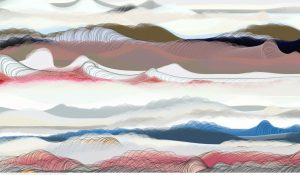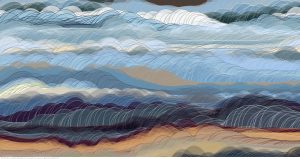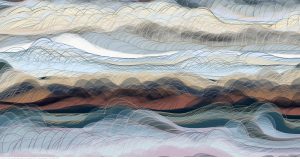project6
//Fon Euchukanonchai
//15-105 SECTION A
//keuchuka@andrew.cmu.edu
//Project-06
//defining arrays for X and Y of gold coins
var A = [196,210,227,141,156,168,183,245,260,204,190,177,222,239, 163, 150, 250, 199, 186, 213, 231, 172, 243, 159, 195, 209, 229, 182, 239, 168, 204, 220, 190, 176, 233, 205, 221, 191, 177, 235,195, 211, 181, 224,199, 213, 184, 226, 210, 198, 184, 202, 190, 217, 186, 199, 213, 191, 206, 200]
var B = [327,327,327,327,327,327,327,327,327,324,324,324,324,324,324,324,324, 319,319,319,319,319,319,319, 314, 314,314,314,314,314, 310,310,310,310,310, 305,305,305,305,305, 303,303,303,303, 298,298,298,298, 294,294,294, 290,290,290, 285,285,285, 280,280, 275];
function setup() {
createCanvas(400, 400);
}
function draw() {
background(255);
//putting time functions in variables
var S = second();
var M = minute();
var H = hour();
//values to shake increase as seconds get higher as it nears one minute
var mShake = map(S, 0, 60, 0, 1.5);
var shake = random(-mShake, mShake)
//map for cloak to expand according to minute value
expandX = map(M, 0, 60, 0, 100 )
expandY = map(M, 0, 60, 0, 30)
//map for cloak to change brightness/darkness according to hour of the day
if (H >= 0 & H <= 12){
hourMap = map(H, 0, 12, 0, 255)
}
if (H >= 12 && H <= 24){
hourMap = map(H, 12, 24, 255, 0)
}
//cloak
beginShape();
fill(hourMap);
noStroke();
curveVertex(91-expandX, 400);
curveVertex(91-expandX, 400);
curveVertex(111-expandX*0.8, 217);
curveVertex(129-expandX*0.65, 96);
curveVertex(178-expandX*0.4, 57-expandY);
curveVertex(218+expandX*0.4, 59-expandY);
curveVertex(270+expandX*0.65, 96);
curveVertex(286+expandX*0.8, 217);
curveVertex(309+expandX, 400);
curveVertex(309+expandX, 400);
endShape();
//face
push();
beginShape();
fill(221, 231, 229)
noStroke();
curveVertex(136, 112);
curveVertex(136, 112);
curveVertex(157, 83);
curveVertex(190, 69);
curveVertex(239, 85);
curveVertex(259, 131);
curveVertex(241, 254);
curveVertex(182, 275);
curveVertex(146, 237);
curveVertex(131, 167);
curveVertex(136, 112);
curveVertex(136, 112);
endShape();
pop();
//inner face
beginShape();
fill(255)
noStroke();
curveVertex(196, 80);
curveVertex(196, 80);
curveVertex(228, 92);
curveVertex(249, 139);
curveVertex(244, 203);
curveVertex(235, 240);
curveVertex(226, 256);
curveVertex(202, 272);
curveVertex(174, 270);
curveVertex(150, 240);
curveVertex(139, 205);
curveVertex(135, 161);
curveVertex(139, 120);
curveVertex(161, 85);
curveVertex(196, 80);
curveVertex(196, 80);
endShape();
//right eyebrow
beginShape();
fill(158, 133, 189);
noStroke();
curveVertex(160, 105);
curveVertex(160, 105);
curveVertex(165, 105)
curveVertex(168, 118);
curveVertex(170, 129)
curveVertex(168, 137);
curveVertex(161, 140);
curveVertex(153, 138);
curveVertex(150, 133)
curveVertex(151, 125);
curveVertex(154, 117);
curveVertex(160, 105);
curveVertex(160, 105);
endShape();
//left eyebrow
beginShape();
fill(158, 133, 189);
noStroke();
curveVertex(230, 105);
curveVertex(230, 105);
curveVertex(237, 112)
curveVertex(245, 131);
curveVertex(242, 139)
curveVertex(236, 141);
curveVertex(230, 140);
curveVertex(225, 136);
curveVertex(225, 123)
curveVertex(226, 113);
curveVertex(230, 105);
curveVertex(230, 105);
endShape();
//left eye
fill(0);
beginShape();
push();
noStroke();
frameRate(1);
curveVertex(146+shake, 152);
curveVertex(146+shake, 152);
curveVertex(152+shake, 149);
curveVertex(163+shake, 147);
curveVertex(172+shake, 151);
curveVertex(175+shake, 157);
curveVertex(170+shake, 162);
curveVertex(159+shake, 164);
curveVertex(145+shake, 159);
curveVertex(146+shake, 152);
curveVertex(146+shake, 152);
pop();
endShape();
//right eye
beginShape();
fill(0);
frameRate(1);
noStroke();
curveVertex(233+shake, 147);
curveVertex(233, 147+shake);
curveVertex(249+shake, 149);
curveVertex(254, 159+shake);
curveVertex(244+shake, 164);
curveVertex(232, 164+shake);
curveVertex(224+shake, 159);
curveVertex(222, 154+shake);
curveVertex(225+shake, 150);
curveVertex(233, 147+shake);
curveVertex(233+shake, 147);
endShape();
//left under eye
beginShape();
fill(131);
noStroke();
curveVertex(161, 170);
curveVertex(161, 170);
curveVertex(171, 168);
curveVertex(172, 168);
curveVertex(164, 175);
curveVertex(149, 172);
curveVertex(148, 170);
curveVertex(161, 170);
curveVertex(161, 170);
endShape();
//right under eye
beginShape();
fill(131);
noStroke();
curveVertex(235, 169);
curveVertex(235, 169);
curveVertex(246, 169);
curveVertex(247, 171);
curveVertex(235, 174);
curveVertex(227, 173);
curveVertex(223, 170);
curveVertex(225, 168);
curveVertex(235, 169);
curveVertex(235, 169);
endShape();
//left cheek
beginShape();
fill(158, 133, 189);
noStroke();
curveVertex(151, 188);
curveVertex(151, 188);
curveVertex(153, 182)
curveVertex(157, 180);
curveVertex(169, 185)
curveVertex(170, 210);
curveVertex(170, 218);
curveVertex(168, 226);
curveVertex(165, 226);
curveVertex(158, 214);
curveVertex(151, 188);
curveVertex(151, 188);
endShape();
//right cheek
beginShape();
fill(158, 133, 189);
noStroke();
curveVertex(242, 190);
curveVertex(242, 190);
curveVertex(239, 207)
curveVertex(231, 226);
curveVertex(226, 224)
curveVertex(224, 190);
curveVertex(230, 180);
curveVertex(238, 181);
curveVertex(242, 190);
curveVertex(242, 190);
endShape();
//chin mark
beginShape();
fill(158, 133, 189);
noStroke();
curveVertex(198, 256);
curveVertex(198, 256);
curveVertex(208, 255)
curveVertex(210, 256);
curveVertex(199, 263)
curveVertex(189, 261);
curveVertex(185, 257);
curveVertex(186, 255);
curveVertex(198, 256);
curveVertex(198, 256);
endShape();
//heart comes up near end of minute
if (S>57){
push();
heart(0,0);
heart(77, 0);
pop();
}
//mouth eating
var mouthExpandx= 0;
var mouthExpandy= 0;
//mouth gets wider at end of minute
if (55 < S & S < 60){
mouthExpandx = map(S, 50, 57, 0, 10);
mouthExpandy = map(S, 50, 57, 0, 50);
}
//mouth shuts at end of minute
if (S > 59){
mouthExpandx = map(S, 58, 60, 10, 0);
mouthExpandy = map(S, 58, 60, 50, 0);
}
//mouth
fill(0);
beginShape();
frameRate(10);
noStroke();
curveVertex(197+shake, 237+shake);
curveVertex(197, 237+shake);
curveVertex(211+shake, 236)
curveVertex(218, 239+shake);
curveVertex(220+shake, 244+shake)
curveVertex(214+mouthExpandx, 249+shake+mouthExpandy);
curveVertex(190+shake, 250+mouthExpandy);
curveVertex(179+shake-mouthExpandx, 248+shake+mouthExpandy);
curveVertex(175, 244+shake);
curveVertex(177+shake, 239+shake);
curveVertex(185, 236+shake);
curveVertex(197+shake, 237+shake);
curveVertex(197, 237+shake);
endShape();
//bowl top
fill(120, 18, 20)
arc(198, 329, 186, 54, 0, PI)
//bowl bottom
fill(239, 59, 57)
ellipse(198, 329, 184, 5)
//calling array values for gold coins every second plus jitter
for (var i = 0; i < S; i++){
frameRate(20);
var shakeX = A[i] + random(-0.5,0.5)
var shakeY = B[i] + random(-0.5 ,0.5)
coin(shakeX, shakeY);
}
}
//gold coin
function coin(x, y) {
push();
translate(x, y);
fill(226, 156, 37);
ellipse(0, 0, 22, 8);
fill(252, 207, 117);
ellipse(0, 0, 19, 5);
fill(255, 232, 192);
ellipse(0, -1, 10, 2);
pop();
}
//heart
function heart(x,y) {
beginShape();
noStroke();
translate(x,y);
fill(255, 0 ,0);
curveVertex(160, 161)
curveVertex(160, 161)
curveVertex(157, 157)
curveVertex(155, 152)
curveVertex(158, 151)
curveVertex(159, 154)
curveVertex(160, 152)
curveVertex(162, 150)
curveVertex(165, 151)
curveVertex(163, 157)
curveVertex(160, 161)
curveVertex(160, 161)
endShape();
}
I wanted to create a clock based on a toy that is based on a character from a Ghibli movie. The seconds are the most apparent from the coins, the size of the cloak follows the minute, and the color of the cloak is based on the hour. I wasn’t too concerned with being able to tell time. Overall this was satisfying to make even though there are issues with the smoothness of animation.



 Exhibition in Kettle’s Yard gallery in Cambridge by John Cage
Exhibition in Kettle’s Yard gallery in Cambridge by John Cage![[OLD FALL 2017] 15-104 • Introduction to Computing for Creative Practice](https://courses.ideate.cmu.edu/15-104/f2017/wp-content/uploads/2020/08/stop-banner.png)
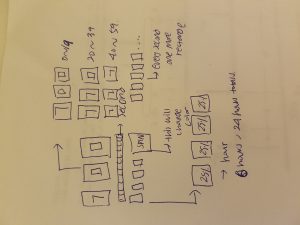

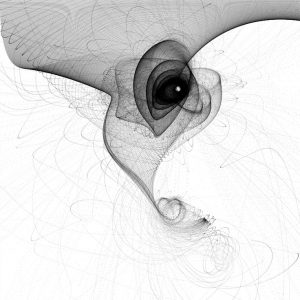

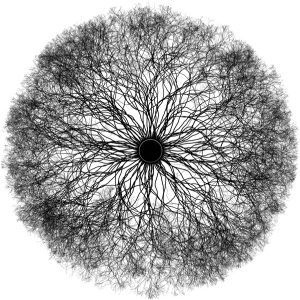
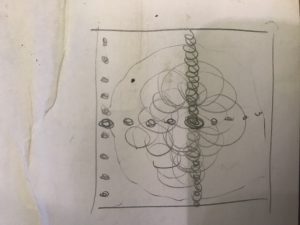

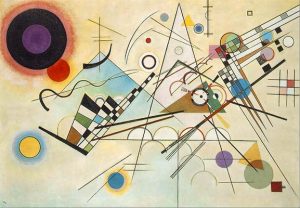
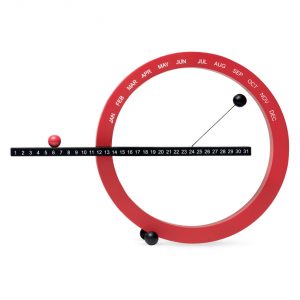
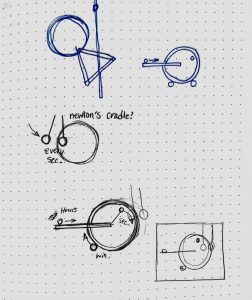 I was inspired by both Wassily Kandinsky’s abstract art and the MOMA’s perpetual calendar. I put the two of these together to create a more minimal version of an abstract clock.
I was inspired by both Wassily Kandinsky’s abstract art and the MOMA’s perpetual calendar. I put the two of these together to create a more minimal version of an abstract clock.